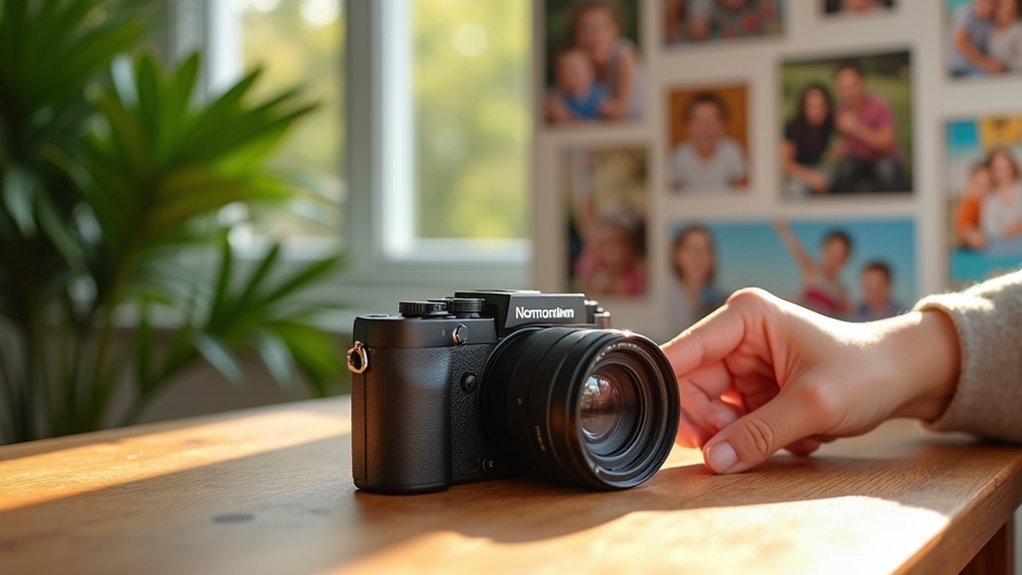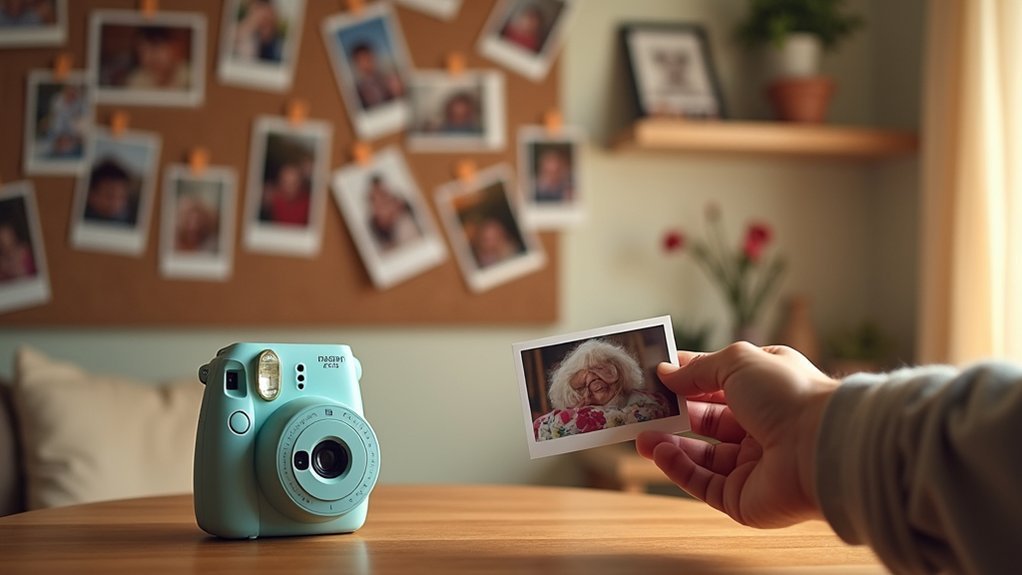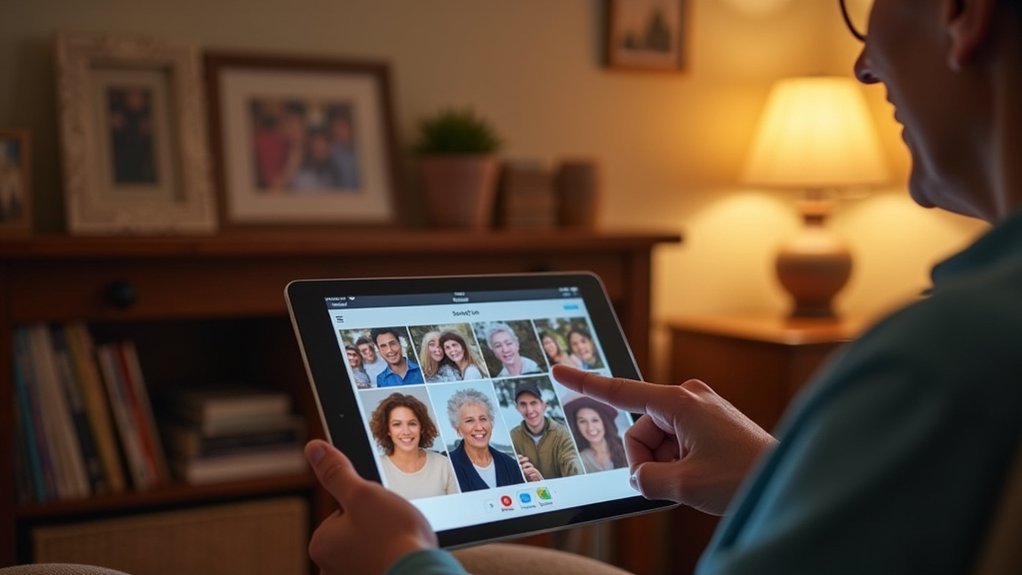Memory-boosting photography gear for dementia patients includes easy-grip cameras with ergonomic handles, voice-activated digital frames, and instant-print cameras for immediate memory triggers. You’ll find lightweight options with adjustable grips that reduce hand strain and smart albums that use facial recognition to enhance connections. Wearable photo viewers like SenseCam can capture daily experiences, helping patients recall three times more information. Discover how these specialized tools can strengthen memory connections and improve quality of life.
Easy-Grip Cameras Designed for Limited Dexterity

While photography requires steady hands and precise movements, specially designed cameras now offer solutions for those with limited dexterity.
Look for models featuring ergonomic handles that reduce hand strain and provide comfortable support during extended use.
Cameras like the Canon R3 include permanent vertical grips, making them easier to handle regardless of orientation.
When selecting a camera, prioritize lightweight construction that won’t tax weakening muscles.
Some models feature adjustable grip sizes to accommodate different hand dimensions, ensuring a secure hold.
Soft grip materials provide essential traction, preventing slippage for those with reduced grip strength.
Regularly performing simple grip strength exercises can help maintain the dexterity needed for camera operation and improve overall hand function.
Consider adding grip-enhancing accessories like specialized straps or handles if your loved one struggles with standard camera designs.
These thoughtful adaptations can make photography accessible despite dexterity challenges.
Digital Photo Frames With Voice-Activated Controls
Voice-activated digital photo frames offer valuable independence to dementia patients who struggle with complex controls but still want to enjoy cherished memories.
You’ll find models that connect with Alexa or Google Assistant, allowing simple commands like “show my vacation photos” or “next picture” without maneuvering through confusing menus.
Setting up these smart frames is surprisingly straightforward—most connect to your home Wi-Fi and can be personalized with specific photo playlists that support reminiscence therapy. The Echo Show 15 stands out as an excellent option with its Alexa voice commands that integrate seamlessly with Amazon Photos for easy viewing.
Voice-Activation Benefits Dementia
Modern digital photo frames with voice-activated controls offer revolutionary support for people with dementia.
You’ll find these devices enable loved ones with limited motor skills to navigate photo collections hands-free, preserving their autonomy and reducing frustration.
Voice commands trigger personalized reminiscence sessions through natural language interactions that feel familiar and comforting. This technology stimulates long-term memory while reducing cognitive load compared to complex touchscreen menus.
The conversational features encourage verbal responses and storytelling, helping maintain communication skills while creating opportunities for meaningful social connections. Family members can remotely upload new photos, fostering ongoing engagement. Similar to how Amazon Echo offers assistance, these frames provide helpful voice-activated support that enhances daily living.
What makes these frames particularly valuable is their adaptability—they can be customized to accommodate changing needs and abilities as dementia progresses, providing consistent support throughout the journey.
Personalization Through Technology
Today’s digital photo frames offer unprecedented personalization through seamless voice-activation technology.
With Alexa integration, you can effortlessly manage photo playlists across multiple frames using simple voice commands. Just ask to display specific memories on designated frames throughout your home.
Most advanced frames connect to cloud services like Google Photos, Amazon Photos, and Flickr, giving you access to extensive photo libraries without manual uploads.
You’re not limited to preset displays either—create custom playlists tailored to each room or family member’s preferences. These innovative frames now feature improved dialogue support for a more natural interaction experience when making connectivity requests.
The intuitive touch bar interfaces and hidden on-screen controls maintain a clean, distraction-free display while providing easy access when needed.
Many frames also include ambient light detection to automatically adjust brightness levels and scheduled on/off times to conserve energy when no one’s viewing.
Frame Setup Simplicity
Setting up traditional photo frames requires constant manual effort, but digital alternatives with voice-activated controls have revolutionized this experience.
These smart frames offer seamless interaction through platforms like Alexa and Google Assistant, enabling you to manage your photo collections with simple voice commands.
You’ll appreciate how these frames minimize physical interaction—perfect for those with limited dexterity. Most connect automatically to Wi-Fi networks and update their software without intervention, eliminating technical frustrations.
When selecting a frame for a loved one with dementia, prioritize high-resolution displays, voice command compatibility, and intuitive interfaces.
The best options offer features like scheduled slideshows and automatic content refreshes. Google’s Nest Hub particularly impresses with its ambient light sensor that automatically adjusts screen brightness based on room conditions. This technology not only simplifies setup but provides cognitive stimulation through familiar images, creating moments of connection and emotional comfort.
Photo-Enhancing Software for Restoring Vintage Memories
Photo-enhancing software revolutionizes how you can breathe new life into faded family treasures, with options like PhotoGlory and VanceAI offering one-click restoration solutions.
You’ll find significant differences in restoration technology, from basic scratch removal to AI-powered colorization that transforms black-and-white photos into vibrant memories. These programs can effectively erase nasty imprints of time, including scratches, stains, and creases from precious photographs.
Most modern restoration tools feature intuitive interfaces designed for non-technical users, with simple drag-and-drop functionality and automatic enhancement options that make preserving your vintage photographs remarkably straightforward.
Subheading Discussion Points
While modern technology continues to revolutionize photography, its impact on preserving vintage memories has been particularly profound. You’ll find AI-powered tools that transform damaged photos into clear, vibrant images that can trigger emotional responses in dementia patients. The patented AI makes photo restoration achievable in just seconds with a single click, offering a straightforward approach for caregivers and family members.
| Software Feature | Benefit for Dementia Patients |
|---|---|
| Automatic Repair | Quickly removes scratches without technical skill |
| AI Colorization | Transforms B&W photos into emotional triggers |
| Resolution Enhancement | Improves clarity for better recognition |
| Metadata Management | Helps organize photos by date or person |
| Batch Processing | Restores multiple family photos efficiently |
These user-friendly platforms work across devices, making them accessible even if you’re not tech-savvy. When incorporated into memory care programs, these restored images become powerful tools for cognitive stimulation, storytelling, and emotional connection—turning faded photographs into gateways to preserved memories.
Restoration Technology Comparison
When comparing photo restoration technologies, you’ll discover a landscape rich with options ranging from free web-based tools to sophisticated AI-powered software.
CodeFormer excels at background noise reduction and clothing texture restoration, while tools like PhotoRestore.io offer free enhancements without subscriptions.
For quick results, consider 老照片修复 (Old Photo Restoration), which processes images in about 10 seconds.
If you’re working with various file formats, Vivid-Pix RESTORE supports JPEG, TIFF, PNG, DNG, BMP, and RAW files.
Most solutions now feature AI-powered colorization, transforming black-and-white photos into vibrant memories. ChatGPT offers free photo restoration with upscale options of 2x, 3x, and 4x resolution enhancement.
When selecting software, weigh technical capabilities like scratch removal and resolution enhancement against your budget and whether you prefer subscription models or one-time purchases.
User-Friendly Interface Options
How easily you navigate photo restoration software can make the difference between frustration and success when preserving precious memories. Kodak’s “Memory Shots” tool exemplifies user-friendly design with its AI-powered simplicity.
| Feature | Benefit |
|---|---|
| Minimal Input Required | Type a brief description and select era |
| Intuitive Editing Tools | Refine images until they match memories |
| Web-Based Access | No software installation needed |
| Face Insertion Option | Add real faces for personal connection |
| Real-Time Adjustments | See changes as you make them |
You’ll appreciate the clean, minimal design that walks you through each step with visual and textual cues. This accessibility empowers both patients and caregivers to create authentic period-specific images that stimulate reminiscence and improve cognitive engagement—all without technical expertise. Memory Shots creates images based on historical Kodak styles, allowing users to generate visuals that accurately represent the time period of their memories.
Wearable Photo Viewers for Continuous Memory Support
As memory disorders progress, wearable photo viewers offer unprecedented support for dementia patients by continuously capturing daily experiences that can later be reviewed.
Systems like SenseCam have proven remarkably effective, with patients recalling triple the information compared to written diaries over a three-month period.
You’ll find these devices are designed to be lightweight and wireless, allowing for unobtrusive wear throughout the day.
They’re particularly valuable for capturing meaningful events that prompt autobiographical recall during review sessions.
While caregivers may initially express privacy concerns, most find these systems easy to operate and worth the adjustment period.
The continuous image capture provides rich visual data that not only supports patients’ memory consolidation but also helps identify behavior triggers and enhances communication between caregivers and healthcare providers.
These innovative solutions can significantly improve quality of care while reducing the emotional and financial challenges faced by caregivers.
Simplified Instant Print Cameras for Immediate Reminiscence

While wearable devices capture memories for later review, simplified instant print cameras offer something more immediate and tangible.
These user-friendly cameras provide instant physical photos that dementia patients can hold, triggering powerful memory recall and emotional connections.
The simplicity of operation makes them accessible for those with cognitive impairments, while the immediate feedback enhances engagement.
You’ll find these cameras particularly valuable for creating memory books and supporting storytelling sessions. The physical prints serve as conversation starters, reducing isolation and promoting social interaction.
Caregivers can integrate these cameras into personalized care routines, using the printed photos as visual aids during reminiscence therapy. Creating sequential visual jigsaw puzzling with Polaroids helps patients connect memories and stories more effectively.
The tactile experience of handling fresh prints stimulates multiple senses, potentially enhancing cognitive function and providing a soothing, familiar activity that preserves identity and dignity.
Tactile Photography Equipment for Multi-Sensory Engagement
Beyond visual memory stimulation, tactile photography equipment offers profound multi-sensory engagement for individuals with dementia. Polaroid cameras deliver instant physical photos that can be handled and touched, creating tangible memory connections.
Consider cameras with varied textured bodies and large buttons that provide satisfying tactile feedback.
Look for photography accessories that enhance sensory experiences, such as textured camera straps, different material tripods, and sensory photo frames. These elements stimulate touch while supporting memory recall.
Personalized photo albums with different textures can further enhance reminiscence activities.
For extensive sensory engagement, explore equipment with vibrational camera grips or audio description capabilities.
Integrating these tactile tools into community photography projects creates meaningful social interactions while stimulating multiple senses simultaneously—helping you connect with your loved one through shared sensory experiences.
Smart Albums With Facial Recognition for Familiar Connections

Smart albums with facial recognition technology represent a powerful advancement in memory support for individuals with dementia. These innovative tools automatically identify and tag faces across photo collections, making navigation intuitive for both patients and caregivers.
Facial recognition in smart albums creates navigable memory pathways for dementia patients and their caregivers alike.
You’ll find these albums reduce social isolation by reinforcing personal connections when familiar faces are identified. The software learns to recognize individuals after initial labeling, creating consistency that dementia patients find reassuring. These tools facilitate emotional connections through photos of familiar faces, which can help spark memories and strengthen relationships with family members.
When searching becomes as simple as asking for “photos with grandchildren” or “summer vacation pictures,” engagement increases dramatically.
For best results, limit each album page to two or three photos on a single topic to prevent cognitive overload.
Combine both physical and digital formats based on your loved one’s preferences, distributing viewing sessions among different family members to enhance social interaction.
Frequently Asked Questions
How Long Do Memory Benefits Last After Photo Therapy Sessions?
Memory benefits from phototherapy are typically short-term. You’ll need repeated sessions to maintain cognitive improvements, as there’s limited evidence for long-term benefits. Individual responses vary, and ideal dosing remains under investigation.
Can Photography Equipment Be Covered by Insurance or Medicare?
Medicare won’t cover photography equipment as it’s not considered durable medical equipment. Your private insurance might cover professional gear, but you’ll need specific photography insurance for full protection of your equipment.
What Training Do Caregivers Need to Implement Photo Therapy Effectively?
You’ll need training in dementia symptoms, photo therapy techniques, technology use, and care plan integration. Learn to create supportive environments, personalize sessions, engage patients effectively, and monitor progress over time.
How Do Photographs Compare to Music Therapy for Dementia Patients?
Photographs and music therapy both improve cognition and mood in dementia patients. You’ll find photos especially good for promoting social interaction and reminiscence, while music therapy’s particularly effective at reducing agitation and anxiety symptoms.
Are There Cultural Considerations When Selecting Photographic Content?
Yes, you’ll need to include culturally relevant images that reflect patients’ backgrounds, traditions, and experiences. Using diverse content helps guarantee patients connect with photos and improves memory recall through familiar cultural touchpoints.
In Summary
You’ve got incredible tools at your disposal to help your loved one reconnect with cherished memories. Whether it’s easy-grip cameras, voice-activated frames, or wearable viewers, these innovations make photography accessible despite cognitive challenges. By incorporating these specialized devices into daily life, you’re not just capturing images—you’re preserving connections and stimulating recognition. Take the first step today, and watch as photographs become bridges to meaningful moments.





Leave a Reply